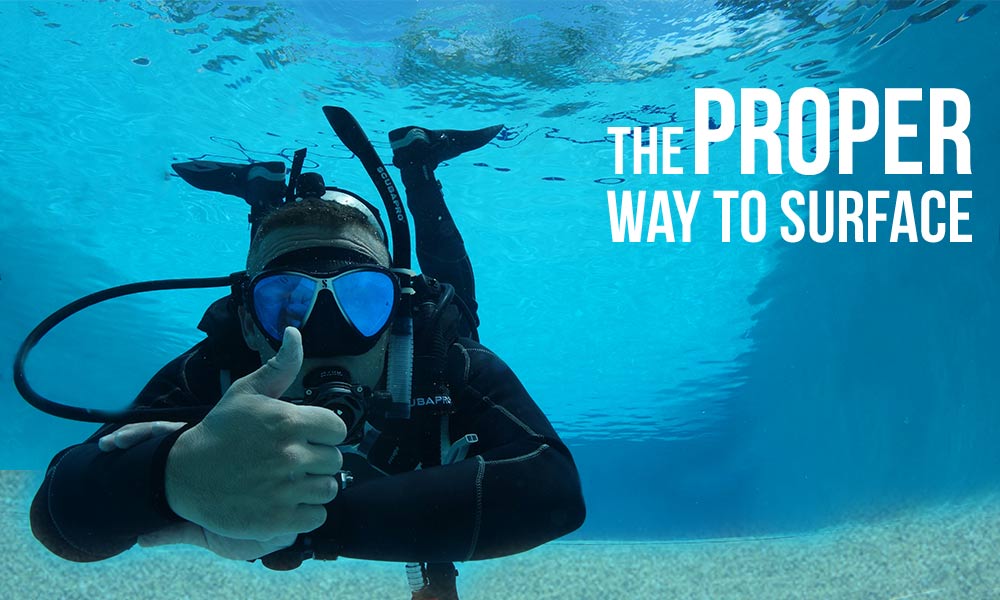The end of your dive has arrived and the preparation to surface starts unfolding in your mind. Have you developed the skills and confidence to execute a proper safety stop and surfacing procedure? Do you have the tools for the job? To the inexperienced diver it might seem as simple as getting to the surface while maintaining a slow ascent rate, but other factors should come into consideration for a proper ascent. Here are a few tips every diver should work on for getting to the surface in an appropriate and safe manner. Are you and your buddy ready to call it a day? Give your buddy the thumbs up and let’s head for the surface!
Gas Management
Throughout the dive, you should have maintained proper gas management and followed your NDL (no decompression limit) enough to have an adequate gas supply reserved for a proper slow ascent and safety stop (while ending the dive with gas to spare). Just because a captain or Divemaster mentions that you may spend X amount of time on the bottom, does not mean you spend that amount of time on the bottom. Follow what your computer tells you, and most importantly, follow what your gas gauge tells you.
Buoyancy
Maintaining good buoyancy is a critical skill to be sustained during the full duration of a dive, but for the purpose of this article, we will solely focus on it as a part of surfacing. As you rise in the water column and pressure decreases, the gas in your BC will expand, causing an increase in buoyancy. As you start your ascent, closely monitor your buoyancy and depth, periodically relieving the expanding gas from your BC to prevent an uncontrolled ascent. Ideally, you want go up only when YOU want to go up. Taking SDI’s Advanced Buoyancy Diver course with a qualified instructor may help fine-tune your buoyancy skills as well as your trim. Also, check out the SDI article “The Art of Buoyancy”.
Dive Flag/SMB (Surface Marker Buoy)
The majority of my dives here in Florida are drift dives, so shooting an SMB from the bottom with a reel is an essential skill, a skill EVERY diver (regardless of level) should learn, in my opinion. You may also be doing some shore diving or following your dive guide, so carrying a dive flag or following one may be an option to ascend on. If you have not become proficient in shooting an SMB from depth, carrying an oral inflation SMB will be your next option. SMBs will not only show your location to the boat captain, it will show others boaters in the area that divers are in the water and to use caution. If you haven’t already, check out Jon Kieren’s article on SMB deployment methods “The Secret Sauce for Surface Marker Buoy (SMB) Deployment”. In addition to a visual marker like an SMB, many divers also choose to carry a whistle or other audible alarm as a means of attention getting.
Look & LISTEN
Be a self aware diver, constantly monitoring your surroundings. You may be the most prepared diver on the planet, but you cannot always prepare for the mistakes of others. It is not only crucial to look and monitor what is below and around you, but above you as well. Surfacing under a dock, boat, fellow diver, fishing lines etc., could end with severe consequence and even injury. While at your safety stop, listen closely for any rapidly approaching boat engines, audible alarms, or other attention getting methods that could help you or fellow divers.
On the Surface
You have successfully and safely made it to the surface; what now? You should work smarter, not harder, as most would say. Go ahead and inflate your BC some to gain buoyancy; there is no need to waste the energy treading water while you wait for the boat. Give a look around to ensure no watercrafts are headed your way. As the dive boat approaches, give the captain an “I’m OK” sign by bringing your arm up and tapping on top of your head with a balled fist. Never approach the boat until the captain or crew instruct you to do so. Be sure to keep your regulator in your mouth and mask in place until you are safely aboard the boat. I personally will also monitor the disengagement of the boat prop before approaching the stepladder. If you had been shore and beach diving, head for your most practical/safe exit point, most likely the same as your entry point while monitoring your surroundings.
Have your own tips for surfacing after a dive? Let’s hear about them in the comments section below.
To find out more about International Training, visit www.tdisdi.com.













































